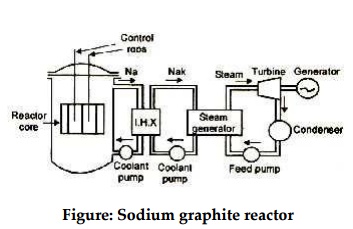Sodium Graphite Reactor (SGA)
Sodium Graphite
Reactor (SGR):
The reactor shown in figure uses two liquid metal coolants. Liquid sodium (Na) serves as the primary coolant and an alloy of sodium potassium (NaK) as the secondary coolant.
Sodium melts at 208°C and boils at 885°C. This enables to achieve high outlet coolant temperature in the reactor at moderate pressure nearly atmospheric which can be utilized in producing steam of high temperature, thereby increasing the efficiency of the plant. Steam at temperature as high as 540°C has been obtained by this system. This shows that by using liquid sodium as coolant more electrical power can be generated for a given quantity of the fuel burn up.
Secondly low pressure in the primary and secondary coolant circuits, permits the use of less expensive pressure vessel and pipes etc. Further sodium can transfer its heat very easily. The only disadvantage in this system is that sodium becomes radioactive while passing through the core and reacts chemically with water. So it is not used directly to transfer its heat to the feed water, but a secondary coolant is used. Primary coolant while passing through the tubes of intermediate heat exchanges (I.H.X) transfers its heat to the secondary coolant. The secondary coolant then flows through the tubes of steam generator and passes on its heat to the feed water. Graphite is used as heat transfer media have certain advantages of using liquids used for heat transfer purposes. The various advantages of using liquid metals as heat transfer media are that they have relatively low melting points and combine high densities with low vapour pressure at high temperatures as well as with large thermal conductivities.


